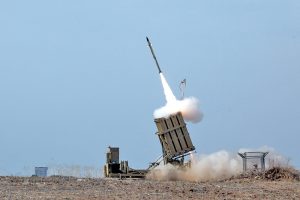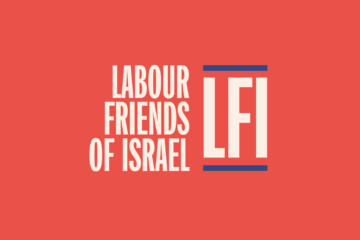
Iron Dome intercepts rockets from Gaza. Credit: Nehemia Gershuni, www.NGPhoto.biz, CC-BY-SA 4.0 via Wikimedia Commons.
The conflict between Israel and militants in Gaza has continued over the past week, with more than 3,750 rockets fired into Israel by Hamas and other terrorist groups and some 2,000 strikes against terrorist targets in Gaza.
What happened
- Conflict began with low-level violence in Jerusalem last week and escalated as Hamas began a barrage of rocket fire into Israel on Monday 10th.
- Hamas rockets have continued over the week, particularly focused on southern Israel.
- Tuesday saw two Thai workers killed in a strike on their workplace, while several people were injured in a direct hit on a home in Ashdod. The IDF has said that some 90% of rockets were intercepted by Israel’s Iron Dome system.
- Israel has conducted a series of strikes against a network of terror tunnels used by Hamas in northern Gaza. Contrary to some speculation, Israeli troops did not enter Gaza.
- Speculation around a ceasefire has developed since the weekend, with reports that one may come in the coming days, likely Friday. LFI has released a statement calling for immediate de-escalation, expressing deep distress at civilian casualties, and condemning Hamas terror attacks deliberately targeting civilians in the strongest possible terms.
More rockets on Israel
Since Monday 10th, more than 3,750 rockets have been fired on Israel by Hamas and other terrorist groups based in Gaza. While Jerusalem, Tel Aviv and other cities in central Israel were bombarded last week, more recent attacks on Tuesday and Wednesday have focused on southern Israeli border towns like Ashdod and Ashkelon. In an attempt to deflect criticism of its indiscriminate attacks on civilians, a Hamas statement claimed to have targeted 6 Israeli air bases in the region too, though none have been hit. Northern Israel, including Haifa, has also experienced some rocket fire from Lebanon in the past week. Palestinian groups in Lebanon – rather than Hezbollah – are thought to be responsible. Since the conflict began, some 12 Israelis are known to have died, with many more injured. Recent casualties have included Ido Avigal, 5, killed by shrapnel from a rocket attack on his home in Sderot; Soumya Santosh, 30, an Indian carer for an 80-year-old Israeli woman; and two as-yet-unnamed Thai men, both in their thirties, who were killed in a direct hit to a packing house they worked at.
Strikes on Gaza
Israel has responded to the rocket attacks with more than 2,000 strikes against Hamas and other terrorist attacks in Gaza.
- Hamas’s internal security HQ, offices, treasuries and bunkers have been targeted.
- Gaza’s Hamas-run Health Ministry has reported a death toll of 219 people, including 63 children. Of these, at least 9 children are known to have been killed by Hamas rockets that landed in Gaza itself.
- The IDF claims to have neutralised more than 160 terrorist operatives as of Tuesday 18th, including Islamic Jihad senior commander Sameh Fahim Al-Mamlouk and Hamas commander Iyad Fathi Faik Sharir.
- The IDF has recorded some 550 instances where Hamas rockets misfired and landed in Gaza itself, leading to casualties and damaging property including an EU-funded sanitation plant.
- Since Thursday 13th, Israel has conducted strikes against a network of terror tunnels in northern Gaza used by Hamas.
- On Saturday 15th, the IDF warned the occupants of the Al Jalaal tower in Gaza, used by international news organisations, that it was a military target. The IDF has since said that the tower housed a Hamas R&D unit and military intelligence personnel that were surveilling Israeli troops and directing attacks on border villages.
Ceasefire on the horizon?
Efforts for a UN Security Council resolution calling for a ceasefire have so far been blocked by the US due to the absence of any mention of Hamas rocket attacks despite extensive criticism of Israel. Senior Israeli officials indicated on Sunday 16th that a ceasefire was coming. Ahead of Sunday’s security cabinet meeting, Walla news was told that American calls for a ceasefire were being heard, and that Israel would start moving toward a ceasefire now that military objectives had been achieved against Hamas. As in previous agreements between Israel and Gaza terror groups, the anonymous officials said that the ceasefire would be mediated by Egypt. Monday 17th saw President Biden explicitly indicate his “support for a ceasefire” in a call with Benjamin Netanyahu, while Biden stepped up the pressure on Wednesday 19th, saying he expected “a significant de-escalation today on the path to a ceasefire”. Ceasefire rumours continue, with talks ongoing despite speculation regarding a breakthrough on Wednesday 19th. On Thursday 20th, a senior Hamas official indicated that a ceasefire could be reached within “one or two days”, as Gaza border communities saw an 8-hour lull in rocket fire overnight. Rockets resumed on Thursday 20th, however.
How did we get here?
Unrest in Jerusalem began last month, when low-level confrontations between Palestinians and Israeli police took place over restrictions at the Damascus Gate during Ramadan.
- Jerusalem saw a wave of attacks on Jews, including beatings, stone throwing and street harassment. Following a march by Lehava, a far-right Jewish extremist group, on 23 April, clashes erupted in which more than 100 people were wounded.
- Subsequent weeks saw terror attacks and attempted terror attacks by Palestinians. There was also a flare up of violence between Israel and Gaza, with more than 40 rockets fired indiscriminately into Israel over a weekend.
- Tensions reignited on the weekend of the 8/9th May. More than 300 people were injured in clashes in Jerusalem, focused around the Temple Mount/Haram al-Sharif complex, which is of religious significance to both Jews and Muslims.
- Confrontations saw rioters throwing rockets and launching fireworks at police from inside the complex, prompting the Israeli security forces to enter. This highly abnormal move may reflect a lack of political leadership caused by Israel’s continuing failure to form a government.
- LFI strongly condemns violence against worshippers and urges Israeli security forces to show maximum restraint.
- Violence also erupted elsewhere, including attacks in other parts of Jerusalem.
Events in the UK
The UK has seen a dramatic rise in antisemitic incidents in the context of the conflict in the Middle East. Between 6 and 16 May, recorded antisemitic incidents soared by 438 percent, with 96.5 percent involving language, imagery or behaviour linking them to the ongoing conflict. On Sunday 16th, a convoy of cars with Palestinian flags drove through north London shouting “F**ck the Jews”, “Rape their daughters” and “F**k their mothers”. Pro-Palestinian marches on Saturday saw Israeli flags destroyed and demonstrators chanting about the massacre and expulsion of Jews at the battle of Khaybar in the seventh century. A rabbi in Chigwell, Essex was also attacked in a “brutal assault”.
What next?
Despite the growing consensus that a ceasefire will come in the next few days, Benjamin Netanyahu made clear on Wednesday that he saw no specific timeframe for an end to the fighting in Gaza, saying “we’re not standing with a stopwatch”. As LFI chair Steve McCabe has recently written, when the ceasefire comes, “the best way to honour those on both sides who have tragically lost their lives” will be to “redouble our efforts” for political dialogue and direct negotiations between the Israeli government and the PA.

